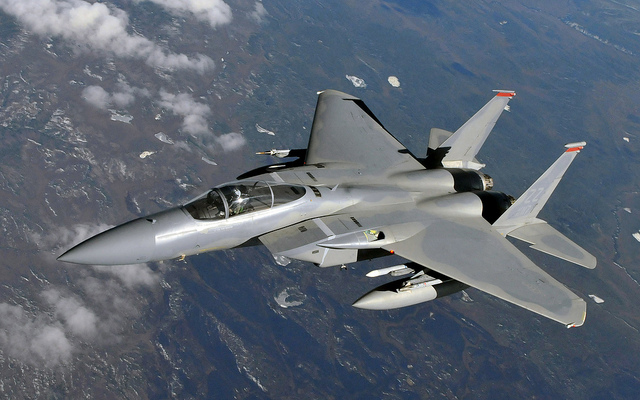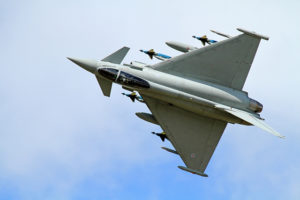The Peninsula
Upgrading South Korea’s Air Force

By Chad 0’Carroll
As the economic crisis continues to lead governments into austerity programs worldwide, South Korea is preparing to sign off on defense contracts totaling over $12 billion this year. The biggest allocation of the budget is being reserved for the purchases of some $7.2 billion worth of next generation fighter jets, representing the last of a three-phase upgrade to the South Korean Air Force. Prospective aircraft include Lockheed Martin’s F-35, EAD’s Eurofighter Typhoon, and an upgraded version of Boeing’s classic F-15 design. But as an ally of the U.S. for so many decades with access to plenty of cutting-edge American technology, why does South Korea need to invest so much in upgrading its air-force now?
In short, because South Korea’s Air Force has until recently relied primarily on decades old aircraft to form the majority of its fleet an upgrade is needed. Although South Korea built 150 modern F-16 fighter jets in the early 1990s, it still relied on the vintage F4 (original design 1958) and F-5-E (original design 1971) to fulfill the majority of the Air Force’s duties until very recently. While the F-4 and F-5-E have proven to be reliable workhorses for the ROK Air Force, China and Japan’s investment in upgrading fleets provides plenty of reason beyond the traditional threat of North Korea to retire these aircraft as soon as possible. This is especially so with the antiquated McDonnell Douglas F-4 fighter, which is the reason that South Korea commenced a three phase “F-X” replacement program back in 2002.
South Korea kicked off the F-X replacement program through their 2002 purchase of 40 F-15Ks from Boeing, ordering a further 20 aircraft during phase two in 2008. But with the F-X plan originally scheduled to comprise of 120 new aircraft, South Korea still has an anticipated 60 units left to order when it decides on what to buy at phase three. This decision will be made by the Defense Acquisition Program Administration (DAPA), a group tasked with reviewing next-generation aircraft bids against four broad sets of criteria. These four sets include cost, capability, interoperability with South Korean forces, and industrial benefits. And of this latter point, reports indicate that South Korea may require the winning bidder to assist with developing its own indigenous KFX fighter development program.
In terms of the threat environment that the ROK currently faces, North Korea’s air force and anti-air capability will play a major role in determining the most suitable aircraft for this phase three order. The Korean People’s Air Force possesses over 800 fighters and bombers in total, most of which are of early Cold War era Soviet and Chinese design. As a result, GlobalSecurity concluded that the North Korean “air force has a marginal capability for defending North Korean airspace and a limited ability to conduct air operations against South Korea.” However, North Korea does possess approximately 40 or so relatively advanced MIG-29 attack fighters, acquired during the mid 90s for protecting airspace above Pyongyang. In terms of its ground-to-air capabilities, North Korea also possesses one of the densest air-defense networks in the world, a system that would need to be quickly overcome prior to any major air based incursion.
In contrast to North Korea’s relatively large air force, South Korea possesses just 500 fighter / bombers in its air force – bolstered by nearly 100 American planes also stationed in-country. But while unable to match the size of North Korea’s air force, South Korea’s modern F16s and F-15s give it a good deal of qualitative superiority over the North. This is further compounded by the fact ROK pilots are given substantially more opportunity to rack up flight training hours; as their counterparts in North Korea face fuel shortages which some suggest give pilots North of the DMZ just 20 hours of flight training per year. However, there is clearly scope for South Korea to improve its air superiority and a burgeoning need to retire the eldest F-4 fleet. But what would be the best aircraft for the ROK Air Force to invest in?
F-15 Silent Eagle
As explained, South Korea already purchased some 60 F-15’s during phases one and two of its acquisition program. With that in mind, there may well be a compelling case to stick with Boeing for phase three and order their further refined (but still under development) F-15 Silent Eagle design. With a planned stealth design, the F-15SE would give substantial advantages to South Korea in times of conflict, allowing the aircraft to get well behind enemy lines without detection. And from both interoperability and maintenance perspectives, there is a lot to be said about investing in one type of aircraft. However, a draw-back with the Boeing option is that the next generation F-15’s stealth capabilities are reportedly far from realization, with only ten percent of work complete as of January 2012. As such, even the newest variation of the F-15 will not provide full stealth capability.
Eurofighter Typhoon
Another option for Seoul to consider is the Eurofighter Typhoon, a modern and robust jet fighter that was designed by the European consortium EADS. While the Eurofighter isn’t a true stealth fighter, the EADS Eurofighter bid does come with one major potential benefit for South Korea – in the area of industrial development. Having previously indicated that South Korea would give preference to those bidders willing to offer it industrial assistance, it is easy to understand why EADS in 2011 invited Korea to join its high-end jet production project. According to reports, an EADS spokesperson said that if Korea chose the Eurofighter, then it would be offered the chance to assemble and partly manufacture the advanced jets in Korea – something that could help Korean engineers in their own indigenous projects.
F-35 Lightning
Perhaps the most technologically advanced of all bids comes in the form of Lockheed Martin’s fifth generation F-35 Lightning aircraft. With the U.S. having ordered nearly 2,500 F-35’s to be deployed over coming years, a major benefit of South Korea investing in the export variant of the F-35 would be to ensure interoperability with the U.S for decades to come. In addition, the F-35 also comes with the benefit of having much better stealth credentials than either the Eurofighter or F-15. But there are nevertheless some problems with the F-35 bid; the speed of the aircraft is just Mach 1.6 (the bare minimum the Air Force has stated as a mandatory requirement) and it doesn’t have the ability to carry weapons externally (another core requirement). Rather puzzlingly though, if South Korea does insist on external weapons capabilities, then F-35s stealth credentials will be significantly reduced – undermining one of the rationales for purchasing a stealth aircraft.
Conclusions
No matter what option South Korea goes for, the new aircraft it orders will help bolster air capabilities and facilitate the retirement of the oldest parts of its fleet. Obviously, North Korea’s capacities also play a role in determining what to choose, but South Korea must also think about long-term deterrence, and remember the fact that Japan recently ordered 42 F-35s and that China plans to introduce its own stealth fighters in the years to come. With the Air Force carrying out tests and evaluations on all three aircrafts from June through September, a decision on which fighter to purchase is expected to be announced in October.
Chad 0’Carroll is the Director of Communications for the Korea Economic Institute. The views represented here are his own.



